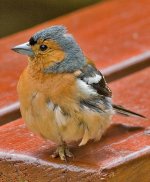digitalbirdy
Well-known member
Both I at home and my wife at work 12 miles away, have noticed that we frequently have Chaffinches with 'strange' feet on our respective feeders.
I have tried looking through binoculars to see what the 'club foot appearance' actually is. It appears as if these have a foot which has got some sort of massive growth all over it.
The good news is, despite this they do seem to manage to just about hang on to a branch and feed.
Currently my wife has 2 at work like this and I have one at home.
Question 1: Is this very common, or do we have a high incidence?
Question 2: What is it, and what is causing it?
Final question: ...we have never seen any other type of bird with anything like this. Is this something that Chaffinches are prone to getting?
Many thanks
Adrian
I have tried looking through binoculars to see what the 'club foot appearance' actually is. It appears as if these have a foot which has got some sort of massive growth all over it.
The good news is, despite this they do seem to manage to just about hang on to a branch and feed.
Currently my wife has 2 at work like this and I have one at home.
Question 1: Is this very common, or do we have a high incidence?
Question 2: What is it, and what is causing it?
Final question: ...we have never seen any other type of bird with anything like this. Is this something that Chaffinches are prone to getting?
Many thanks
Adrian




